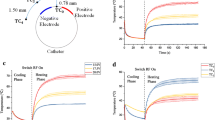Abstract
. Excimer laser recanalisation of in-stent restenosis may be a viable modality for improving coronary patency. However, the presence of arterial stents modifies the thermal properties of the irradiated area and may alter temperature patterns generated during ablation. The goal of this study was to evaluate, in vitro, temperature changes during excimer laser ablation of stented vessels and compare them with those obtained from unstented (control) vessels. Six different stent types (AVE Microstent-II, AVE-GFX, ACS Multi-link, JJ Palmaz-Schatz, JJ Crown, and NIR) were deployed in freshly excised porcine coronary vessels. Three control unstented samples were also measured. Blood or saline was infused through the vessels, while the tissue environment was kept at ∼37°C. A 308 nm excimer laser (Spectranetics, CVX300) with an eccentric 2.0 mm laser catheter (Spectranetics, EII) delivered two trains of 200 pulses each, 10 s apart, at 60 mJ/mm2, and 40 Hz, simulating maximum clinical exposure. The catheter was positioned midway in the stent, first coaxially parallel to the vessel wall, and then at an angle against the stent and vessel wall. Temperature measurements (n=168 for blood, n=96 for saline) were performed with a ∼210 µm diameter, fast-response thermocouple with 0.1°C resolution. The probe was positioned to within ∼250 µm from the inner surface of the vessels. Tissue temperature was measured at the catheter tip and at the distal and proximal edges of the stents. Maximum recorded temperatures for coaxial and angular alignment, did not exceed 42.2°C (∼6°C above baseline) and 54.2°C (∼18.1°C above baseline) respectively, for all stents types tested, controls, and all probe locations. Both stented and unstented vessels exhibited comparable temperature gradients. The observed maximum temperatures, obtained under extreme lasing conditions, indicated that 308 nm ablation, in the presence of stents under blood or saline infusion, produces clinically acceptable temperatures.
Similar content being viewed by others
Author information
Authors and Affiliations
Rights and permissions
About this article
Cite this article
Papaioannou, T., Yadegar, D., Vari, S. et al. Excimer Laser (308 nm) Recanalisation of In-stent Restenosis: Thermal Considerations. Lasers Med Sci 16, 90–100 (2001). https://doi.org/10.1007/PL00011348
Issue Date:
DOI: https://doi.org/10.1007/PL00011348




